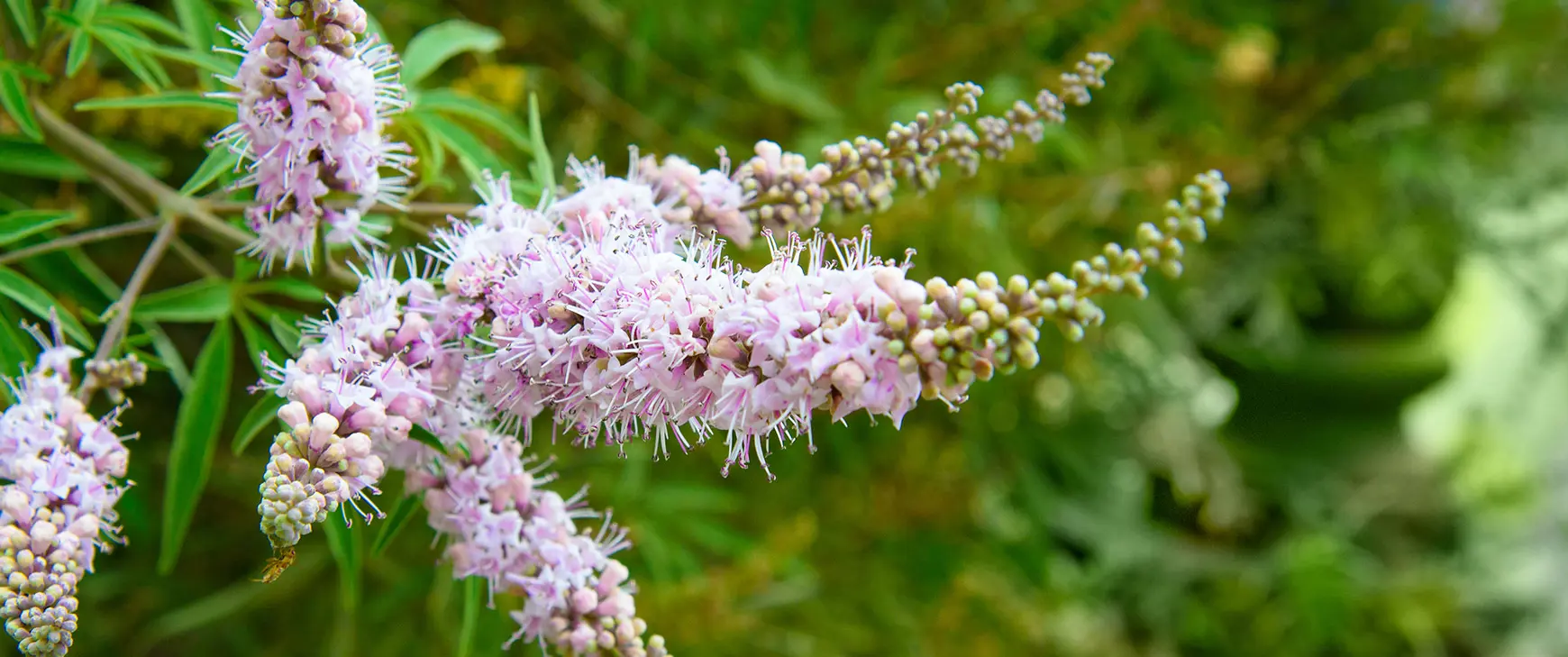
Phyto Story - Monk’s pepper (Vitex agnus-castus L.)
Monk’s pepper is a herbal product that is used to treat premenstrual syndrome (PMS) and menstrual cycle disorders.
Monk’s pepper (Latin Vitex agnus-castus L. or Agnus castus in abbreviated form) is also known as chaste tree or chasteberry. It was deemed to be an anaphrodisiac in the Middle Ages. Nowadays it is used primarily for PMS, but also for irregular menstrual cycles and to help women who are having difficulty conceiving. The effect of the herbal medicine is probably attributable to, among other things, its inhibition of the hormone prolactin. Find out more here about monk’s pepper, its properties and uses.
November 2, 2020
Appearance and prevalence of Vitex agnus-castus L.
Monk’s pepper belongs to the Vitex genus and thus to the Verbena family. Its five- to seven-fingered leaves resemble those of the hemp plant. Vitex agnus-castus grows as a one to five metre high shrub in the entire Mediterranean region and through to the Crimea. This medicinal plant prefers moist soil and a warm to moderate climate. It is often found on embankments or near water. The large, thick inflorescences consist of numerous small blue-violet, white or pink blossoms. Seeds, which look similar to black peppercorns, develop from the blossoms.
Vitex agnus-castus is sometimes also cultivated in gardens as an ornamental plant. The shrub presents its attractive inflorescences right through into late summer. They are similar to those of the butterfly bush. The plant is particularly popular in wild gardens and in apiaries. It flowers from July to August and offers honey bees, wild bees and bumblebees welcome food with its many nectar-rich flowers.
Chasteberry, monk’s pepper, Agnus Castus – the history of the plant names
There are often interesting stories behind the name of a plant – also in the case of Monk’s pepper. The part of the name “pepper” stems from the fruit, which look like peppercorns and taste hot. But why “monk”? This name probably stems from the fact that the medicinal plant was thought to reduce the libido in the Middle Ages. According to medieval sources, they were used as an anaphrodisiac, i.e. the opposite of an aphrodisiac. Monks are said to have eaten the monk’s pepper fruits and slept on the leaves of the plant to diminish their sex drive and to suppress the “reprehensible sins of the flesh”. This is also reflected in traditional names of the plant such as chaste tree or chasteberry. The Latin name Agnus castus has a similar meaning and translates something like “virginal lamb”. However, scientific research on female patients has not confirmed the purported anaphrodisiac effect (reduction of the libido) of monk’s pepper fruit.
Ingredients and effect of monk’s pepper
Vitex agnus-castus contains, among others, essential oils, diterpenes, flavonoids and iridoid glycosides (for example, aucubin and agnuside). Extracts from the dried fruit of the medicinal plant are used for herbal remedies. These minimise the release of the prolactin hormone, perhaps via a dopamin related mechanism of action.
Prolactin is responsible for the growth of the female breasts during pregnancy. During the breastfeeding period, prolactin ensures that breast milk is produced. Researchers have been able to show that PMS syndrome and an irregular cycle in women may be connected with an increased level of prolactin.
Applications of Agnus castus
Extracts from monk’s pepper fruit are often used to treat PMS and traditionally also menstrual cycle disorders (overly heavy or irregular menstrual bleeding). Furthermore, monk’s pepper is sometimes recommended at the beginning of the menopause when menstrual bleeding becomes increasingly irregular.
Premenstrual syndrome: PMS
In the case of premenstrual syndrome (PMS), the symptoms occur up to 14 days before the onset of menstruation. Typical symptoms of PMS include headaches, abdominal pain, skin changes, a feeling of tension in the chest, a feeling of “being bloated”, sleeping problems and fatigue. Psychological symptoms are also common. Many women are irritable, tense, depressed or moody. The symptoms usually decrease with the onset of the menstrual bleeding.
Irregular monthly cycle
A woman’s cycle lasts an average of 28 days. Ovulation takes place around 14 days before the onset of menstruation. If nidation of a fertilised egg cell does not occur, the mucosa of the uterus is expelled in the form of menstrual bleeding. However, the cycle of many women can be longer or shorter. Medications with monk’s pepper extract have a regulatory effect on the menstrual cycle.
Monk’s pepper for women who wish to conceive
Many women who wish to conceive also take preparations containing monk’s pepper. A regular menstrual cycle is important for the maturation of the egg cell. Menstrual cycle disorders can be one reason why some women do not conceive. If the duration of a woman’s cycle fluctuates, it is far more difficult to determine when ovulation occurs. If a woman has difficulty conceiving because of irregular periods, natural medications with monk’s pepper may help to regulate her cycle.
Please note: Herbal remedies may also have interactions and side effects. For this reason, please consult your doctor or pharmacist if you have any questions.
Topics
Filter blog posts by topic by clicking on the tags.




